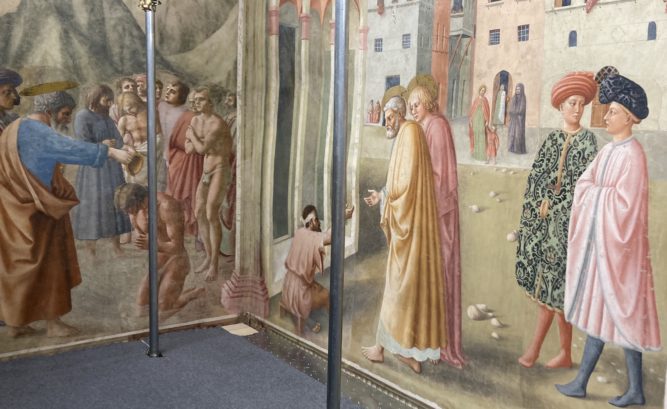Visits to the Brancacci Chapel Restoration

The Brancacci Chapel, a part of Florence Civic Museums, will be undergoing restoration starting in February of 2022. Visitors are still welcome for a close up look on the scaffolding, but no guided tours are allowed. The chapel will be open Friday, Saturday and Monday from 10 am to 5 pm, and Sunday from 1 to 5 pm, with reservations. A lift is installed to enable the disabled to access the scaffolding. Admission is limited and reservations can be booked online with the purchase of tickets at the official ticket office, by writing to info@musefirenze.it or by calling 055 2768224.
Located in the Basilica of Santa Maria del Carmine, situated in Piazza del Carmine, the chapel is often referred to as the “Sistine Chapel of the Early Renaissance” due to its art treasures. Founded by the Brancacci family in the late 14th century, the wealthy silk merchant family commissioned Masolino and his colleague Masaccio to paint a cycle of frescoes based on the life of St. Peter.
But Masolino departed for Hungary and Masaccio left for Rome in 1427 abandoning the unfinished frescoes. A few years later Felice Brancacci fell into political disfavor due to his anti-Medici stance and was exiled. It was not until the 1480s, after the Brancacci family was permitted to return from exile, that the work was finished by Filippino Lippi.
Art historians attribute Masaccio with artistic innovations which ushered in the new Renaissance style of painting. Along with the resurgence of the cultural and intellectual movement of Humanism, Masaccio was a pioneer in painting subjects with human emotion. Using the technique of chiaroscuro to express shadow and light, he also used perspective to show realistic depth and space. The artist was bold to display Adam and Eve nude, not seen in art since Roman and Greek times. But three centuries later, during the time of Cosimo III di’Medici, vine leaves were painted over the subjects’ genitals to comply with standards of current decorum.
Masolino’s contributions to the cycle exhibit the more decorative and stylized International Gothic style of the era. Nevertheless, he used a vanishing point in some of the paintings, demonstrating his implementation of Renaissance innovations. Even though Masaccio was 18 years his junior, Masolino’s evolving works reveal the younger man’s influence. It is said that Michelangelo and Ghirlandaio, also inspired by the young Masaccio, came to sketch from the frescoes in the Brancacci Chapel.
The last restoration of the Brancacci Chapel dates back to the 1980s. Upon inspecting the works in 2020, disintegration such as loosening plaster and deposits of dirt and grime were observed. Currently the most up-to-date techniques providing in-depth knowledge of the original materials and techniques are being employed. Photographic imaging including infrared, high-definition light can discern abnormalities imperceptible to the human eye.
The restoration project, under the direction of the Opificio delle Pietre Dure, supported by American Friends of Florence Foundation and the Jay Pritzker Foundation, is expected to take a year. During the restoration process, the chapel remains open to the public, providing a unique opportunity to go up on the scaffolding and observe the frescoes eye to eye, unlike the vantage point normally only seen from the ground floor. Imagine seeing up close the emotion and angst in the faces of Adam and Eve tempted by the serpent and then being expelled from Paradise. Or the expressions of gratitude and relief on the faces of the poor in the work The Distribution of Alms.
All visitors must show their Super Green Pass or equivalent certification of complete vaccination and masks are required. (rita kungel)
